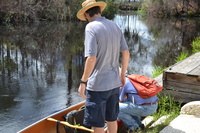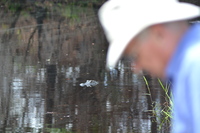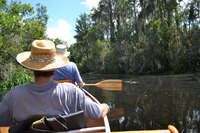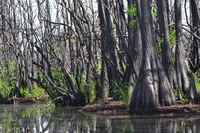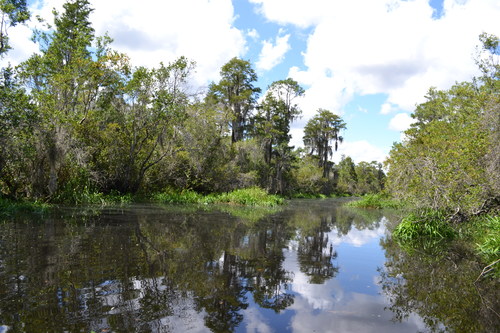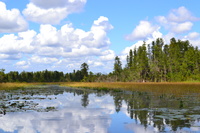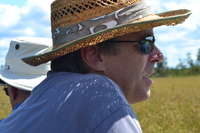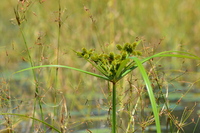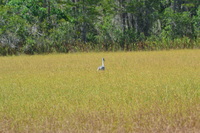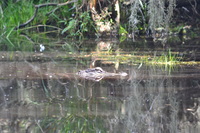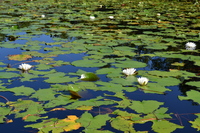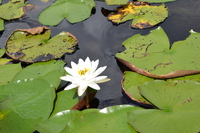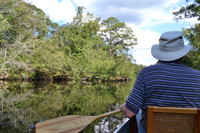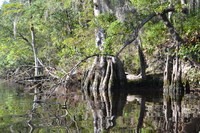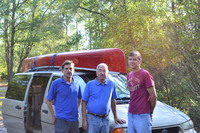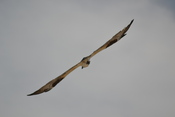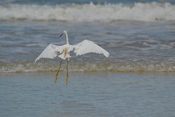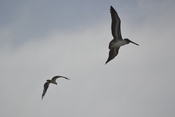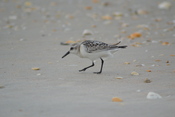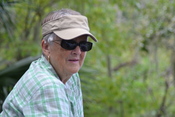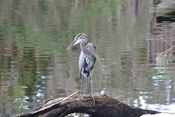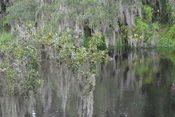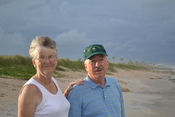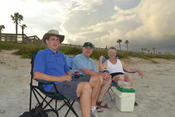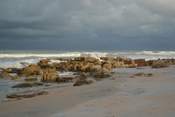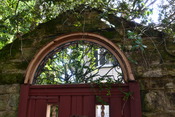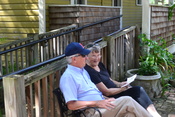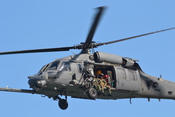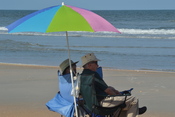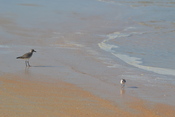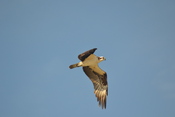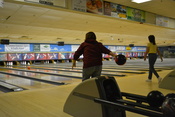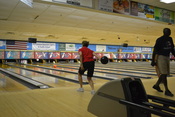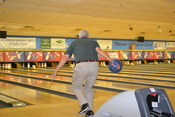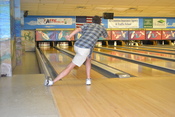|
Into the Okefenokee Swamp September 23-25, 2011 | ||||||||||||||||||||
What sort of place would have a name like that? It sounds a little bit unreal, perhaps as fictional as its most famous resident "Pogo" the possum. But the place is very real and the name is filled with an even deeper mystique. It comes from "Hitchiti", which is an extinct Indian language and means "land of trembling earth". It is a swamp which covers 1,770 square kilometers (680 square miles), about two-thirds the size of Rhode Island. 20 miles across and 30 miles from north to south with out a single road and very little solid land. A land of alligators and cypress trees. Why are we going there?
So this past spring I mentioned camping in the Okefenokee to him and that again seemed to peak his interest. Now I know that dragging Dad off to some birding paradise will always interest him -- but this seemed somehow disproportionate. In any case our plans evolved and we picked a date in late September and we talked Stephen into joining us. And then, to my surprise, Mom and Dad escaped to the very gateway of the swamp in August to do some reconnaissance.
Dad bought this book on-line and I have now read it and I think I understand a bit better his fascination with the Okefenokee. The book is about a boy who lived, traveled and had adventures in the swamp. It is the high adventure of a naturalist; the Indiana Jones of biology. There is a episode where they are searching to the rarer plant 'Franklinia alatamaha' and end up chasing after an ivory billed wood-pecker. They are also long list of the flora and fauna of the swamp. Did my father became a list maker and naturalist because of this book, or did he enjoy this book because of who he already was? At the end of September I flew to Florida and on Friday, September 23, Steve, Dad and I headed into the swamp.
Friday, September 23, 2011 Steve arrived at 10 Summerwind and we soon had Dad's canoe on Steve's van and the rest of our food and geared stowed. I think we have enough provisions for an expedition into a deep wilderness and since Georgia is a new state to me -- maybe it is just enough.
We arrived at the Okefenokee National Wildlife Refuge a bit before noon and so lunched before we launched. We registered at the trailhead and then slipped the canoe into the black waters of the swamp. The sun is brilliant, the temperature is about 90 and the humidity is also well up there. I know southerners will think nothing of this weather, but it gives a northerner pause. It is like the hottest days of July in New Hampshire and I double check my sunscreen, water bottle and broad-brimmed hat. From a dozen yards away an alligator watches us as we step into our canoe. A pair of eyes and bit of it snout barely break the surface. Like an iceberg, most of it hidden from sight. It submerges as we head its way and paddle down the Suwannee Canal.
Today the canal is a portal to the rest of the swamp. It is a dozen yards wide and I have no idea how deep. I am cautions about sticking my arms into black waters when I have recently seen an alligator. The banks are higher then the land beyond them, undoubtedly remains from the excavating. On these ridges grow a line of trees. The first mile is dominated by the slash pine, dripping with Spanish moss. It has been a dry year here and there have been wild fires. The tall pines and cypress and gnarled brush on the south bank are scorched black. Yet even in this burn, new life emerges. The grasses and ferns are green and the trees have sprouted new leaves - a spring like chartreuse or mint green -- defiant in its vitality among the black. The pines have lost all of their needles to the fire, but now they are growing back. Curiously, often the tips of branches are dead, but the trunks are alive, so the new growth is on the trunks and not the extremities.
After two other short excursions we ended up paddling south, into "Chesser Prairie". A "Prairie" is an open grassy area which just happens to be a few inches below water level. It is not what I expected, that is before I had read "Swamp Boy" yesterday. The trail here is about 8 meters wide and filled with lily pads. Although the water has flooded the prairie, the trail feels like a stream in the midst of that grass land. After about half a mile we come to the motor-boat limit. Beyond that the trail is much thicker, choked with lily pads. We pushed on for another half mile.
Actually we are not alone. A Great Egret soars over us and then lands on the prairie and wades through the tall grass. Gangly looking Sandhill Cranes also are fishing in the tall grass. And overhead there always seems to be a vee-shapes black speck, a vulture soaring, climbing on a thermal. Steve is in "Cleopatra's Seat" today, while Dad and I paddle. We sit for awhile when the trail becomes too thick, but then eventually turn and head back. Back on the canal the alligators await us. It is cooler here then the prairie, with tall trees and deeper waters. Pairs of eyes above the water and not much else. Back at our launch site we pack up and head to our cabin at the "Okefenokee Paradise". It is good to get out of the sun and heat. Supper is a spicy chili and in the evening we drive into Folkston for ice cream and to watch the trains go by. Then back to our cabin for long conversations into the night.
Saturday, September 24, 2011 We were all up at 7:00 and Steve made us coffee. We sat out on the front porch of the cabin. The day is pleasant and cool at this hour. We sat and sipped and talked. After breakfast we headed about 15 miles north to Kingfisher Landing and again paddled into the swamp on an old canal. I think some of these canals were used to harvest the cypress - an attempt to make a few dollars when the draining of the swamp proved to be too expensive. Again there were a few alligators at the start but none when we ventured into shallow waters and bold sunlight. This morning Steve is in the stern, captain of our ship, I am in the bow and Dad is the Queen of the Nile. About a mile from the launch we leave the canal and head towards Duck Lake and Durdin Prairie. Here we meet an angler in a kayak. He has escaped from work for a few hours and is the only person we will meet in the swamp. The day is blue with a few puffy clouds. The forecast calls for a chance of rain in the afternoon and the temperatures again climbing to the 90's with a similar humidity. I've brought my raincoat because it is a habit, but I think if it rained I would turn my face to the sky, let myself be drenched and smile. However it doesn't rain. We dip our paddles in the brown waters stained with tannin and will our canoe to slide across the prairie to the south. The conversation moves about as fast as our canoe, past baseball and why would anybody want to be an umpire, around our children, over long ago hikes and so on.
The water grew shallower and narrower and we were soon poling our way up the trail. Eventually we could go no further and so stopped. I was tempted to step out on what appears like the banks of the trail. But this is the Okefenokee -- the "land of trembling earth". I have read that in the swamp a great deal of what appears to be solid ground is really a mat of vegetation floating on deeper waters and that people have been know to plunge through this mat. Apparently there are whole island which float. Some even have trees on them and will support you. I like the idea, the image, of an island which could be blown to a different part of the lake. It sounds like something out of Doctor Doolittle. Eventually we turn ourselves around and made our way north across Duck Lake (barely a prairie in the dry season) and then east on the canal. We passed the alligators and landed at King Fisher landing again. After lunch we stopped by the Okefenokee Visitor Center and then visited the "Swamper's Homestead". This homestead dates from 1927 and included a mill for pressing sugar cane and basins for cooking down the syrup. Finally we drove over to the St. Mary's river, a few miles east of the swamp for one last chance to dampen a paddle. We put in at Tracy's Ferry Landing. This was a much different place then the launches into the swamp. There is a ramp here for trucks, trailers and motor-boats. When we carried the canoe down to the water we had to thread our way around a young family. They had a four year old boy who I think was just learning to swim -- and having a great time doing it.
Paradise, Kentucky is in Muhlenberg county and John Prine wrote a song about it with the chorus: And daddy, won't you take be back to Muhlenberg CountyTo get to Paradise you drive by the strip mines and power plants they feed. Paradise now is just a simple boat landing on the Green River. A place where you can have a picnic and go swimming, or launch a boat and go fishing. The landing on the St. Mary's is a lot like that. We pointed the bow upstream, although with such a slight current the distinction was marginal. Gum trees, cedar and cypress crowded the banks of the river. I like how the cypress seem to stretch out their toes into the glassy waters of the St. Mary's. We talked and paddled until we had gone far enough. Dad was in the bow this time, Steve again in the stern and I in the lap of luxury. That evening we dined in Folkston at the "Okefenokee Restaurant". I had hoped to be feasting on alligator and possum, but it was not to be.
Sunday, September 25, 2011 We had breakfast, cleaned up, packed up and headed south to Palm Coast, Florida. | ||||||||||||||||||||
|
Just a few additional photographs of the rest of my time in Florida.
Sunday
Monday
Tuesday
In the evening Steve and I watched the Bulldog Marching Band practice -- who's star is named Smith. I then dined at Steve, Terri and Allyson's home. Wednesday
|
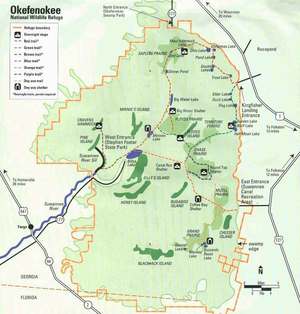
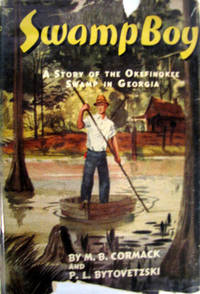 A curious incident on that trip was a stop at a local library where Dad talked with the children's librarian and described a book about the swamp which he had read as a boy. The librarian puzzled over this, but a few days later emailed him with a title "Swamp Boy" by Cormack & Bytovetzski.
A curious incident on that trip was a stop at a local library where Dad talked with the children's librarian and described a book about the swamp which he had read as a boy. The librarian puzzled over this, but a few days later emailed him with a title "Swamp Boy" by Cormack & Bytovetzski.
